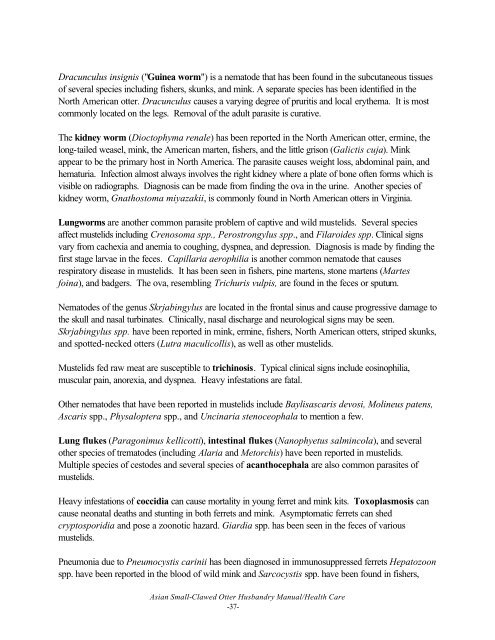Asian Small-Clawed Otter Husbandry Manual (1998)
Asian Small-Clawed Otter Husbandry Manual (1998)
Asian Small-Clawed Otter Husbandry Manual (1998)
You also want an ePaper? Increase the reach of your titles
YUMPU automatically turns print PDFs into web optimized ePapers that Google loves.
Dracunculus insignis ("Guinea worm") is a nematode that has been found in the subcutaneous tissuesof several species including fishers, skunks, and mink. A separate species has been identified in theNorth American otter. Dracunculus causes a varying degree of pruritis and local erythema. It is mostcommonly located on the legs. Removal of the adult parasite is curative.The kidney worm (Dioctophyma renale) has been reported in the North American otter, ermine, thelong-tailed weasel, mink, the American marten, fishers, and the little grison (Galictis cuja). Minkappear to be the primary host in North America. The parasite causes weight loss, abdominal pain, andhematuria. Infection almost always involves the right kidney where a plate of bone often forms which isvisible on radiographs. Diagnosis can be made from finding the ova in the urine. Another species ofkidney worm, Gnathostoma miyazakii, is commonly found in North American otters in Virginia.Lungworms are another common parasite problem of captive and wild mustelids. Several speciesaffect mustelids including Crenosoma spp., Perostrongylus spp., and Filaroides spp. Clinical signsvary from cachexia and anemia to coughing, dyspnea, and depression. Diagnosis is made by finding thefirst stage larvae in the feces. Capillaria aerophilia is another common nematode that causesrespiratory disease in mustelids. It has been seen in fishers, pine martens, stone martens (Martesfoina), and badgers. The ova, resembling Trichuris vulpis, are found in the feces or sputum.Nematodes of the genus Skrjabingylus are located in the frontal sinus and cause progressive damage tothe skull and nasal turbinates. Clinically, nasal discharge and neurological signs may be seen.Skrjabingylus spp. have been reported in mink, ermine, fishers, North American otters, striped skunks,and spotted-necked otters (Lutra maculicollis), as well as other mustelids.Mustelids fed raw meat are susceptible to trichinosis. Typical clinical signs include eosinophilia,muscular pain, anorexia, and dyspnea. Heavy infestations are fatal.Other nematodes that have been reported in mustelids include Baylisascaris devosi, Molineus patens,Ascaris spp., Physaloptera spp., and Uncinaria stenoceophala to mention a few.Lung flukes (Paragonimus kellicotti), intestinal flukes (Nanophyetus salmincola), and severalother species of trematodes (including Alaria and Metorchis) have been reported in mustelids.Multiple species of cestodes and several species of acanthocephala are also common parasites ofmustelids.Heavy infestations of coccidia can cause mortality in young ferret and mink kits. Toxoplasmosis cancause neonatal deaths and stunting in both ferrets and mink. Asymptomatic ferrets can shedcryptosporidia and pose a zoonotic hazard. Giardia spp. has been seen in the feces of variousmustelids.Pneumonia due to Pneumocystis carinii has been diagnosed in immunosuppressed ferrets Hepatozoonspp. have been reported in the blood of wild mink and Sarcocystis spp. have been found in fishers,<strong>Asian</strong> <strong>Small</strong>-<strong>Clawed</strong> <strong>Otter</strong> <strong>Husbandry</strong> <strong>Manual</strong>/Health Care-37-
















